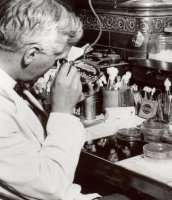Fleming's fungus still surprising scientists

(PhysOrg.com) -- From the moment that a spore of fungus fell onto Alexander Fleming's culture plate in 1928 and killed the bacteria around it, that fungus was destined to become one of the most studied organisms on the planet. But despite eight decades of lavish attention from scientists, it seems there may have been a case of mistaken identity.
The fungus that contaminated Fleming’s bacterial culture in his messy laboratory in St Mary’s Medical School (which became part of Imperial College London in 1988) was later ascribed to the species Penicillium chrysogenum. Now scientists at Imperial have subjected preserved specimens of Fleming’s fungus to modern genetic analysis, and discovered that it’s actually a closely-related species which has yet to be named.
Dr. Matthew Fisher and Dr. Daniel Henk from the School of Public Health, who led the research, also asked volunteers around the world to collect fungal spores from the air by leaving out pieces of sticky tape overnight. They compared genetic data from Fleming’s fungus with the samples posted back by their international collaborators to see what modern science would reveal about the natural history of the celebrated mould. They found that there may be four different species lurking under the label of P. chrysogenum, at least two of which are found all over the world.
"Our study highlights the amazing biodiversity of these airborne fungi," Dr. Henk said. "Fleming and everyone else since really had no idea what they were dealing with. With the genetic techniques we've brought to bear we suddenly can see all these biological differences because we can put the isolates in the right groups. Some may ultimately lead to new useful compounds."
The study is published in the journal Molecular Ecology, and was supported by a grant from the Leverhulme Trust.
Provided by Imperial College London
















